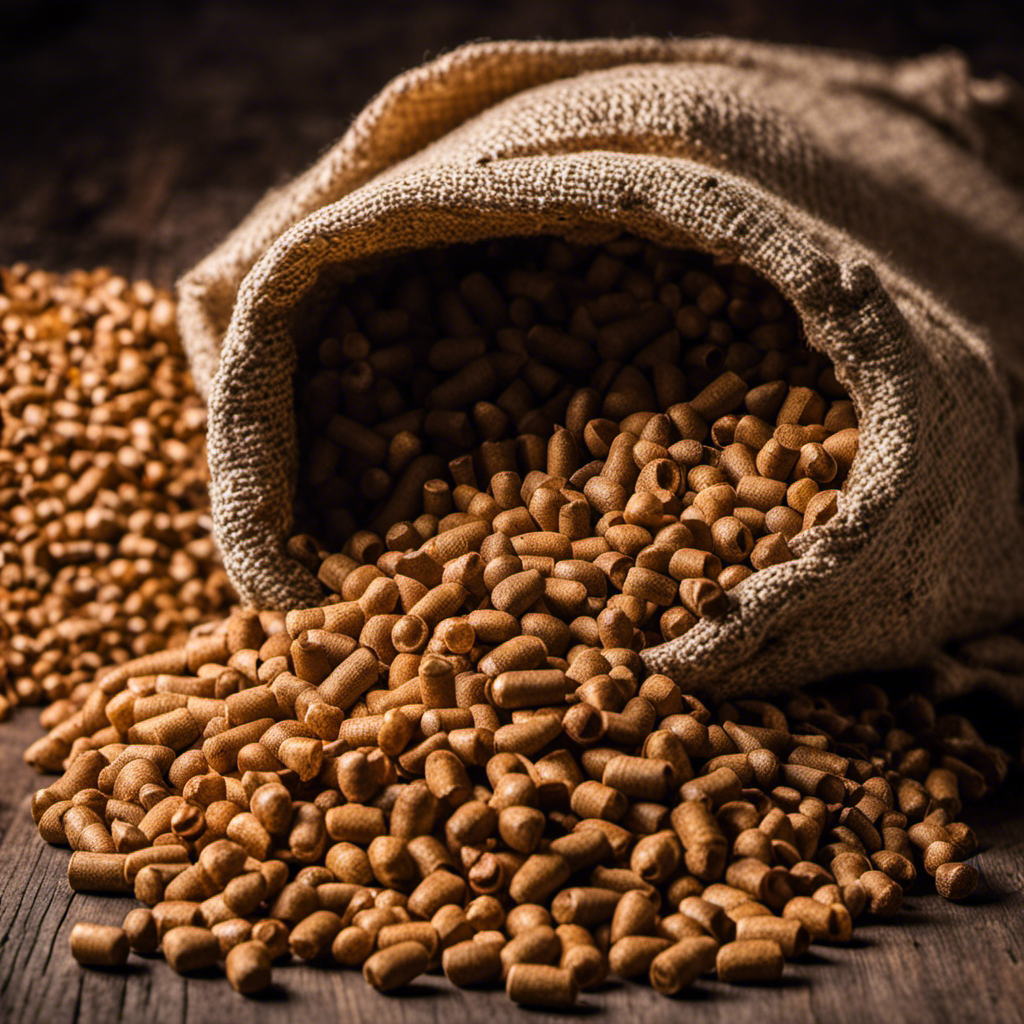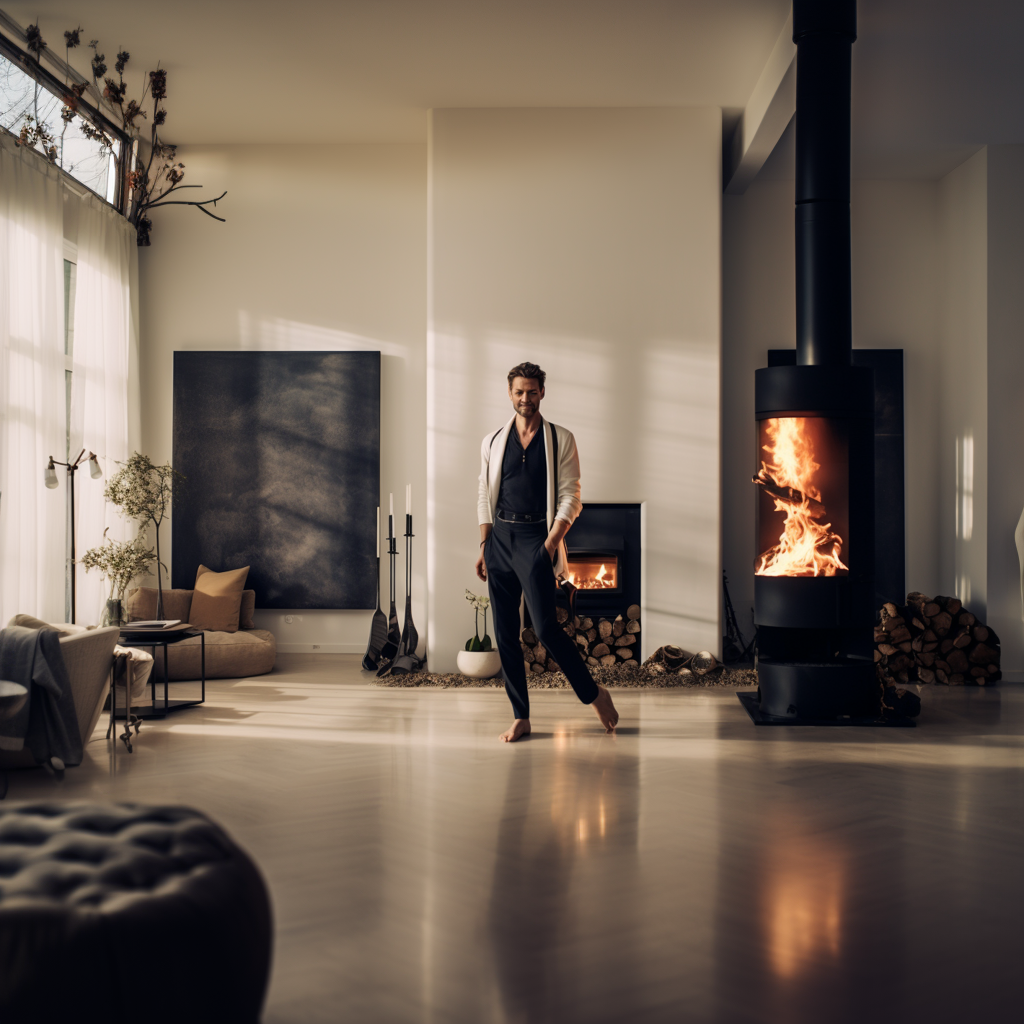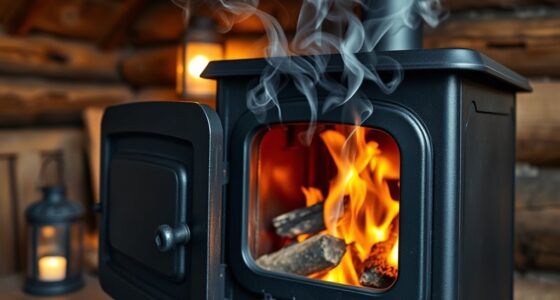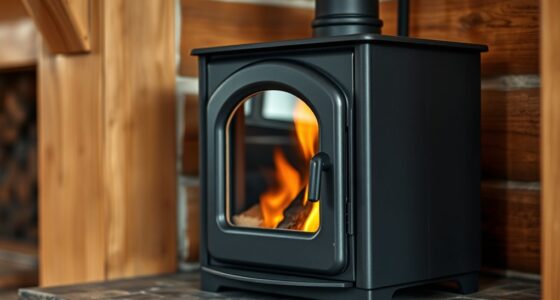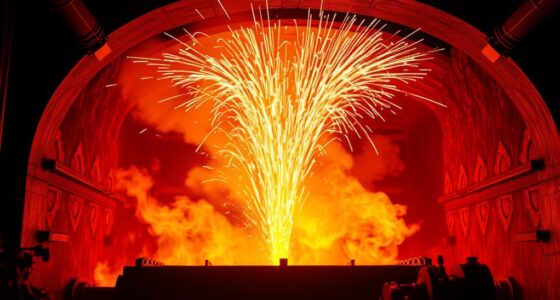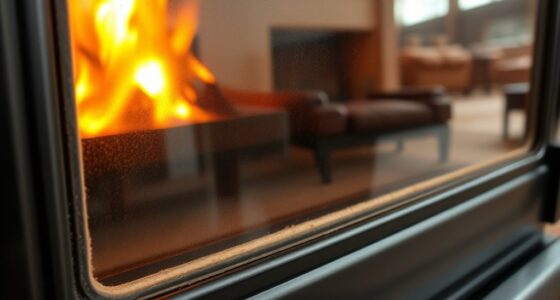As a parent, recognizing the significance of fostering a secure and supportive space for my kids is of utmost importance. This sparked my curiosity in investigating the safety of wood stoves in households with children.
In this article, we will delve into the potential hazards of wood stoves, discuss childproofing strategies, and highlight the significance of proper installation and maintenance.
I’ll also share expert advice and alternative options for families like ours. So, let’s dive in and ensure the safety of our little ones together.
Key Takeaways
- Install safety gates and heat-resistant barriers to create a secure environment and prevent children from accessing the wood stove area.
- Educate children about the dangers of wood stoves, including burns and carbon monoxide poisoning.
- Ensure proper installation and regular maintenance of the wood stove to minimize risks.
- Consider alternatives like gas fireplaces or electric heaters for families with children to eliminate the risks associated with wood stoves.
Safety Precautions to Consider When Using a Wood Stove
When using a wood stove, it’s important to remember to install a safety gate to prevent children from getting too close to the hot surfaces. Childproofing strategies are essential to ensure the safety of your little ones around a wood stove.
In addition to a safety gate, there are other precautions you can take. One option is to create a heat resistant barrier around the stove by installing a protective screen or glass door. This barrier will prevent accidental contact with the hot surfaces, reducing the risk of burns.
It is also important to keep flammable objects away from the stove and to teach your children about the dangers of touching the stove or playing with fire. By following these safety measures, you can create a secure environment for your children around the wood stove.
Now, let’s discuss the potential hazards of wood stoves in homes with children.
Potential Hazards of Wood Stoves in Homes With Children
As someone who’s concerned about the safety of children in homes with wood stoves, it’s important to take certain precautions to minimize the risks.
First and foremost, it’s crucial to ensure that the wood stove is properly installed and maintained, following all safety guidelines provided by the manufacturer.
Additionally, childproofing the area around the wood stove is essential to prevent accidents. This can include installing a safety gate or a heat-resistant barrier.
Lastly, educating children about the dangers of the wood stove and teaching them how to stay safe around it can greatly reduce the chances of accidents occurring.
Safety Precautions for Wood Stoves
It’s important to take safety precautions with wood stoves in homes with children. As a parent, I understand the need to create a safe environment for my little ones.
When it comes to wood stoves, there are several childproofing strategies that can be implemented to prevent accidents. One effective measure is installing a heat resistant barrier around the stove. This acts as a physical barrier, preventing children from coming into direct contact with the hot surfaces.
There are various options available for heat resistant barriers, including metal screens, glass panels, or heat-resistant tiles. These barriers not only provide protection but also add a stylish touch to the room.
By implementing these safety measures, we can ensure that our children are protected from the potential hazards of wood stoves.
Now, let’s move on to the next section and explore how to childproof wood stove areas without compromising their functionality.
Childproofing Wood Stove Areas
To childproof the area around your wood stove, consider installing a safety gate. This is one of the most effective childproofing strategies to prevent children from accessing the stove and getting burned. A safety gate creates a physical barrier that keeps children at a safe distance. When choosing a safety gate, make sure it is sturdy and securely mounted to the wall. Opt for a gate with a childproof lock that is easy for adults to operate but difficult for young children to figure out. Additionally, ensure that the gate is tall enough to prevent climbing. By installing a safety gate, you can provide a secure boundary around the wood stove area and have peace of mind knowing your child is protected from potential dangers.
Now that you have childproofed the area around your wood stove, it is important to educate your children about the dangers associated with it.
Educating Children About Dangers
Parents should educate their kids about the potential hazards of using a wood stove. It is crucial to raise child safety awareness when it comes to these heating appliances. Fortunately, there are various educational resources available that can assist parents in teaching their children about the dangers associated with wood stoves.
Online videos, interactive websites, and informative books are just a few examples of the resources that can be utilized. By providing children with this knowledge, they can understand the importance of staying away from hot surfaces, not playing with fire, and the risks of burns and carbon monoxide poisoning. With this foundation of knowledge, children are better equipped to make safe decisions around wood stoves.
Transitioning into childproofing strategies for wood stoves, it is essential to implement measures that prevent access and reduce the risk of accidents.
Childproofing Strategies for Wood Stoves
As a parent, it is crucial to take proactive measures to childproof your wood stove area.
Three key points to consider are safety gate installation, heat-resistant barrier options, and proper ventilation measures.
Installing a safety gate around the wood stove area will create a physical barrier and prevent your child from accessing it directly.
Additionally, considering heat-resistant barrier options, such as heat-resistant glass or metal screens, will provide an extra layer of protection.
Lastly, ensuring proper ventilation in the room where the wood stove is located will help reduce the risk of carbon monoxide buildup and maintain a safe environment for your child.
Safety Gate Installation
Make sure you’re installing safety gates in the appropriate areas of your home to keep your children away from the wood stove. Safety gates are an essential part of childproofing your home, especially when it comes to preventing accidents around wood stoves.
To ensure the effectiveness of your safety gates, regular maintenance is crucial. Check the gates periodically for any loose screws or damaged parts, and make necessary repairs or replacements. Additionally, consider safety gate alternatives, such as play yards or fireplace screens, for added protection. These alternatives can provide an extra layer of security and prevent your children from accessing the wood stove area.
Now, let’s move on to discussing heat-resistant barrier options to further enhance the safety of your home.
Heat-Resistant Barrier Options
Installing heat-resistant barriers can provide an additional layer of protection in your home, ensuring the safety of your family. Heat-resistant barrier materials, such as fire-resistant bricks or ceramic tiles, can help protect your walls and floors from the intense heat emitted by the stove. These materials are specifically designed to withstand high temperatures, reducing the chances of a fire spreading to the surrounding areas. When choosing heat-resistant barrier materials, make sure to look for safety certifications that guarantee their effectiveness and durability. By investing in these barriers, you can create a safer environment for your family and enjoy the warmth and coziness of your wood stove.
When it comes to wood stoves, it’s crucial to take proper precautions to minimize the risk of accidents and injuries. Proper ventilation measures are also essential when it comes to wood stoves.
Proper Ventilation Measures
Proper ventilation is essential for maintaining a safe and comfortable environment when using a wood stove. Here are some important considerations for ventilation requirements and minimizing carbon monoxide risks:
-
Ensure the wood stove is installed with proper ventilation systems, such as a chimney or vent pipe, to allow for the safe release of combustion gases.
-
Regularly inspect and clean the chimney or vent pipe to prevent blockages, which can lead to the buildup of dangerous gases indoors.
-
Install carbon monoxide detectors near the wood stove and throughout the house to provide early warning of any potential leaks.
-
Keep windows and doors slightly open when using the wood stove to allow fresh air to enter and circulate the room.
-
Avoid using the wood stove in a tightly sealed or poorly ventilated area, as this can increase the risk of carbon monoxide buildup.
Ensuring proper installation and regular maintenance of wood stoves is crucial, especially in homes with children.
Importance of Proper Installation and Maintenance for Wood Stoves in Homes With Children
It’s crucial to ensure that wood stoves in homes with children are installed and maintained correctly. The importance of professional installation cannot be emphasized enough. A professional installer will have the expertise to properly position and secure the wood stove, ensuring that it meets all safety standards.
Regular maintenance is also key to keeping the wood stove operating safely. This includes cleaning the chimney and flue regularly to prevent dangerous buildup, checking for any leaks or cracks in the stove, and ensuring that all components are functioning properly. By adhering to a regular maintenance schedule, you can address any potential issues before they become hazards.
Transitioning into the next section, it’s also essential to educate children about the dangers of wood stoves to further enhance their safety.
Educating Children About the Dangers of Wood Stoves
To keep your family safe, make sure you teach your kids about the potential hazards of using a wood stove. Educating children about the dangers of wood stoves is an essential step in ensuring their well-being.
Start by explaining to them that wood stoves can get very hot and can cause severe burns if touched. Teach them to never touch the stove or its surrounding area when it’s in use. Additionally, emphasize the importance of keeping a safe distance from the stove, especially when it’s lit.
It’s also crucial to teach children about the dangers of playing with fire and the importance of never throwing anything into the stove. By educating children about these potential hazards, you can empower them to make safe choices and prevent accidents.
Transitioning into the next section about alternatives to wood stoves for families with children, it’s important to consider other options that may be safer for your family.
Alternatives to Wood Stoves for Families With Children
If you’re concerned about the safety of your family and want to explore other options, consider looking into alternative heating sources for your home. There are several child-friendly heating options available that can help create a safe environment for children.
One option is a gas fireplace, which provides warmth without the need for burning wood. These fireplaces are equipped with safety features such as glass doors and temperature controls, making them a safer choice for families with young children.
Another alternative is an electric heater, which eliminates the risk of burns or fires associated with traditional wood stoves. Electric heaters are easy to use and can be placed out of reach of children.
By choosing child-friendly heating options, you can ensure the safety of your family while keeping your home warm and comfortable.
When it comes to wood stoves, it’s important to take extra precautions if you have children in your home. Expert advice on ensuring the safety of wood stoves in homes with children can help you minimize the risks associated with these heating sources.
Expert Advice on Ensuring the Safety of Wood Stoves in Homes With Children
When using a wood stove in a home with children, experts recommend implementing safety measures to minimize potential risks. It is important to childproof your wood stove area and educate your children about the dangers it poses.
Here are some childproofing strategies and tips for educating children about the dangers of wood stoves:
- Install a sturdy safety gate or barrier around the wood stove area to prevent children from getting too close.
- Use heat-resistant guards or screens to prevent accidental contact with the hot surfaces of the stove.
- Store matches, lighters, and fire-starting materials out of children’s reach.
To educate children about the dangers of wood stoves, teach them about fire safety and the importance of not touching or playing near the stove. Show them how to safely use the stove and explain the potential dangers associated with it.
Frequently Asked Questions
How Do I Childproof My Wood Stove to Keep My Children Safe?
To childproof my wood stove and keep my children safe, I would start by installing a safety gate around the stove. I would also use heat-resistant barriers and teach my kids about the dangers of touching the stove.
Are There Any Alternative Heating Options for Homes With Children?
There are alternative heating options available for homes with children. Safety measures should be a top priority when considering these options. Let me share some practical and authoritative information on this topic.
What Are the Potential Hazards of Wood Stoves in Homes With Children?
Wood stoves can pose potential health risks for children. It’s important to follow safety guidelines, such as installing proper barriers and keeping children supervised. Regular maintenance and proper ventilation are crucial for a safe home environment.
How Can I Educate My Children About the Dangers of Wood Stoves?
I’ll start by discussing how to educate children about the dangers of wood stoves. It’s important to teach them about the risks and establish clear rules. Childproofing the wood stove area is also crucial for their safety.
What Are the Safety Precautions to Consider When Using a Wood Stove?
Childproofing wood stoves is crucial to ensure a safe environment for children. Implementing safety measures like installing a barrier or gate, keeping flammable materials away, and teaching kids about the dangers are essential precautions.
Conclusion
In conclusion, it is crucial to prioritize the safety of our homes, especially when considering wood stoves with children. By implementing safety precautions, childproofing strategies, and maintaining proper installation, we can significantly reduce the potential hazards associated with wood stoves.
Additionally, educating children about the dangers and exploring alternative heating options can further ensure their well-being. Remember, just as a well-tended fire warms our homes, so too should we nurture the safety of our little ones, ensuring their protection like a sturdy hearth guards against harm.
Stay informed, stay vigilant, and keep your home safe.
Logan’s affair with adventure began in childhood. He hailed from a small town where vast forests bordered one side and endless shores stretched on the other. His days were spent exploring uncharted woods, climbing tall trees, or listening to the tales of old sailors. This early immersion in a world brimming with stories and mysteries became the foundation of his passion for writing.


